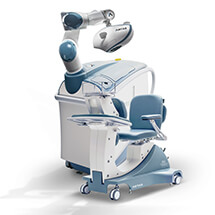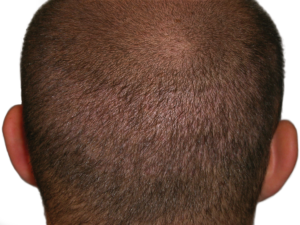What is Artas Robotic System?

At Musk Clinic, staying up-to-date on the most advanced technology in hair restoration and offering the best hair transplant techniques available anywhere in the world is always the main priority. For these reasons, we have invested in the world’s most technologically advanced hair transplant technology, the Artas 9x Robotic FUE (Follicular Unit Extraction).
Artas Robotic Hair Restoration is currently the world’s most popular and advanced robotic Hair Transplant technology. Musk is the only clinic in India using the latest version of this robotic technology : Artas9X
The ARTAS® Robotic System is the most advanced technology for surgical hair restoration. It aids the physician in performing Follicular Unit Extraction (FUE) hair transplant procedures with accuracy and consistency that allows for maximum preservation of follicles.
Developed by the research engineers at Restoration Robotics, Inc., Mountain View, California, the ARTAS robot has been USFDA-approved for robotic hair transplant surgery since the spring of 2011. It is currently the world’s most popular and advanced hair transplant procedure.
In Robotic FUE, follicular units are removed directly from the back and sides of the scalp using robotic techniques, making use of artificial intelligence to minimize injury to follicles.
All of our hair restoration procedures are performed under local anaesthesia. Hair transplant sessions that use thousands of follicular unit grafts may take a whole day or even two consecutive days; however, medications are given to relax you and the time goes by quickly. For part of the procedure, you will be offered a movie selection and cable T.V. Most patients choose to listen to music, watch a movie, or just chat with the doctor and staff.
The misconception that most people have of hair transplantation is associated with the out-dated plug techniques in which patients have significant bleeding and pain. In modern follicular unit hair transplants, the only pain in the entire procedure is for 2-3 minutes while numbing the scalp which feels like small ant-bites. There is no pain during and after the hair transplant procedure and there are absolutely no side-effects associated with it.
The Procedure
When you arrive for your hair transplant, the staff begins by going over the activities for the day. The surgical consent form that had been sent to you is reviewed and other paperwork is completed. The physician reviews the goals that have been established and answers any questions that you might have. The doctor will carefully re-draw the hairline that was marked and photographed during your consultation and will add other markings to further delineate the extent of the procedure. You will have a chance to examine and discuss them before proceeding. The physician will then take high-quality photographs that will become part of your permanent medical record.
Sedatives are given to relax you before the start of the hair restoration procedure, but you can remain fully alert if you like. You will be offered a movie selection and cable T.V. Most patients choose to listen to music, watch a movie, chat, or just relax.
The length of your procedure will depend upon how many follicular unit grafts are transplanted. Smaller sessions generally take one day. Larger FUE sessions will be performed on consecutive days.
We do this very technical job in a friendly, relaxed atmosphere so your experience is pleasant and the time goes by quickly. You will be able to take a series of breaks, to the restroom, to eat, or just to move around and stretch. Many of our patients tell us that all the attention they received throughout their procedure made the experience truly enjoyable. Our full-time staff has years of experience assisting with these procedures. In addition to expertise in performing the procedures, the staff is adept at ensuring the comfort of our patients.
We take great precautions to protect both our patients and ourselves from blood-born agents during the hair transplant procedure. Our patients and staff are routinely tested for HIV and hepatitis for everyone’s safety and protection. Instruments are either sterilized in an autoclave or are disposable.
After sedatives are given orally and intra-muscularly, we use a special customized local anaesthesia cocktail which makes sure that there is absolutely no pain during the entire procedure. High-frequency vibration is applied to the skin as the anaesthetic is given to decrease the sensation of the injections (this is referred to as vibratory anaesthesia). The anaesthetic is administered only around the perimeter of the scalp (called a ring block) to make the entire scalp numb. Once the scalp is numb, the remainder of the hair restoration surgery is painless. If more anaesthesia is required, usually around 5-6 hours into the procedure, it will be given before the initial medication wears off.
Donor Tissue

In Follicular Unit Extraction (FUE), the donor tissue is removed from a broad area of the back and sides of the scalp. The location of the donor area is chosen to have long-term stability. The hair in the area to be removed is clipped short, to a length of approximately 1-mm. This will include the entire back and sides of the scalp in large sessions and a long, thin band in smaller procedures.
In robotic FUE, the patient sits leaning forward, with his/her forehead on a special headrest. As the robot moves around the donor area, scanning select follicles, one-by-one, it begins to separate the follicular units from the surrounding tissue. Once the selected follicular units are removed from a specified area, they are placed in a holding solution of cooled HypoThermosol. This solution closely mimics the body’s own fluids and thus maximizes the survival of grafts while they are being held outside the body.
Once the grafts are extracted, the donor area is covered with antibiotic ointment and a dressing that will be removed the following morning.
Stereo-Microscopic Dissection
In Robotic FUE, extracted grafts are placed under a microscope to assess their integrity and to sort them according to the number of hairs they contain. In cases where a particular size follicular unit is needed, such as for the frontal hairline, larger units may be microscopically dissected into smaller 1-hair grafts (if the number of naturally occurring groups are not sufficient). In eyebrow restoration, for example, where all single-hair grafts are needed, this is particularly important.
Creating Recipient Sites
In manual FUE, there are two basic problems when it comes to creating recipient sites. One is that the human hand & eye co-ordination can’t precisely judge & create the hair angle and thus leading to an aesthetically unpleasing hairline. The second problem with the manual Site making is that there is significant damage to the natural existing hair that can happen.
Comparatively in Robotic FUE, both these chances of human errors are removed because the Robot can precisely create the recipient sites with the correct hair angle without causing any damage to the existing natural hair. This helps in achieving a natural aesthetic hairline such that no one can figure out that one has got a hair transplant done.
Recipient sites are made by the hair transplant surgeon using a fine instrument the size of 19- gauge hypodermic needles. For most procedures, we use lateral (perpendicular slits) for the recipient sites. The creation of the recipient sites determines much of the aesthetic look of the transplant – it sets the angle at which the new hair grows and determines the distribution and density of the grafts. Recipient site creation is a critical aspect of hair transplant surgery that requires considerable experience and surgical skill as well as a keen aesthetic sense.
Graft Insertion
Once all of the recipient sites are made, the surgical team begins to place the follicular unit grafts into these pre-made sites. One-hair follicular units are used in the frontal hairline to give a soft, natural appearance and 2- and 3-hair grafts are used in the central forelock area to achieve maximum fullness. Placing is the most time-consuming part of the hair loss surgery. Graft placement is an exacting process and during this period you will be asked to keep your head relatively still. Watching movies, TV or sleeping, will make the time go by quickly and, of course, you may take breaks as needed to go to the restroom, stretch or eat.
Post Procedure
When placing is complete, the position of all of the grafts will be double-checked. The post-op instructions will be explained and a printed copy will be given to you to take home. This will include the doctor’s cell phone number. A tennis bandage is placed around the scalp to cover the donor area. No bandages or dressings are required on the transplanted area and all dressings can be removed the following morning or day after. Throughout the procedure and afterward, Dr. Shah and our highly trained staff will answer your questions and take care to help you feel comfortable.
ARTAS vs STRIP

ARTAS Robotic FUE and Manual FUE
Time to feel the wind in your hair again – Artas 9x Robotic Hair Restoration comes to India.
Deciding to have a hair transplant is a big life choice and understanding the difference between the procedure types is paramount. One of the popular “buzz words” in hair restoration today is “FUE hair transplant”.
The biggest issue with manual FUE is the factor of human error. It is virtually impossible for the human eye to predict hair angle under the scalp or have exact details of each hair graft to ensure precision and accuracy while performing the procedure.
Artas Robotic Hair Restoration is currently the world’s most popular and advanced hair transplant technology. It is a physician controlled robotic FUE hair transplant guided by Artificial Intelligence. ARTAS does 3-D mapping of the patient’s scalp and hair follicles by scanning each hair follicle 60 times per second, something that the human eye is not capable of. That is not all, based on your customised hair design plan, it transplants the new hair in the correct angle and direction for a more natural looking result. While doing so, it also prevents the existing hair from damage. This ensures the best possible result for the patient.
Artas 9X Robotic Hair Transplant is exclusively available in India at Musk Clinic.